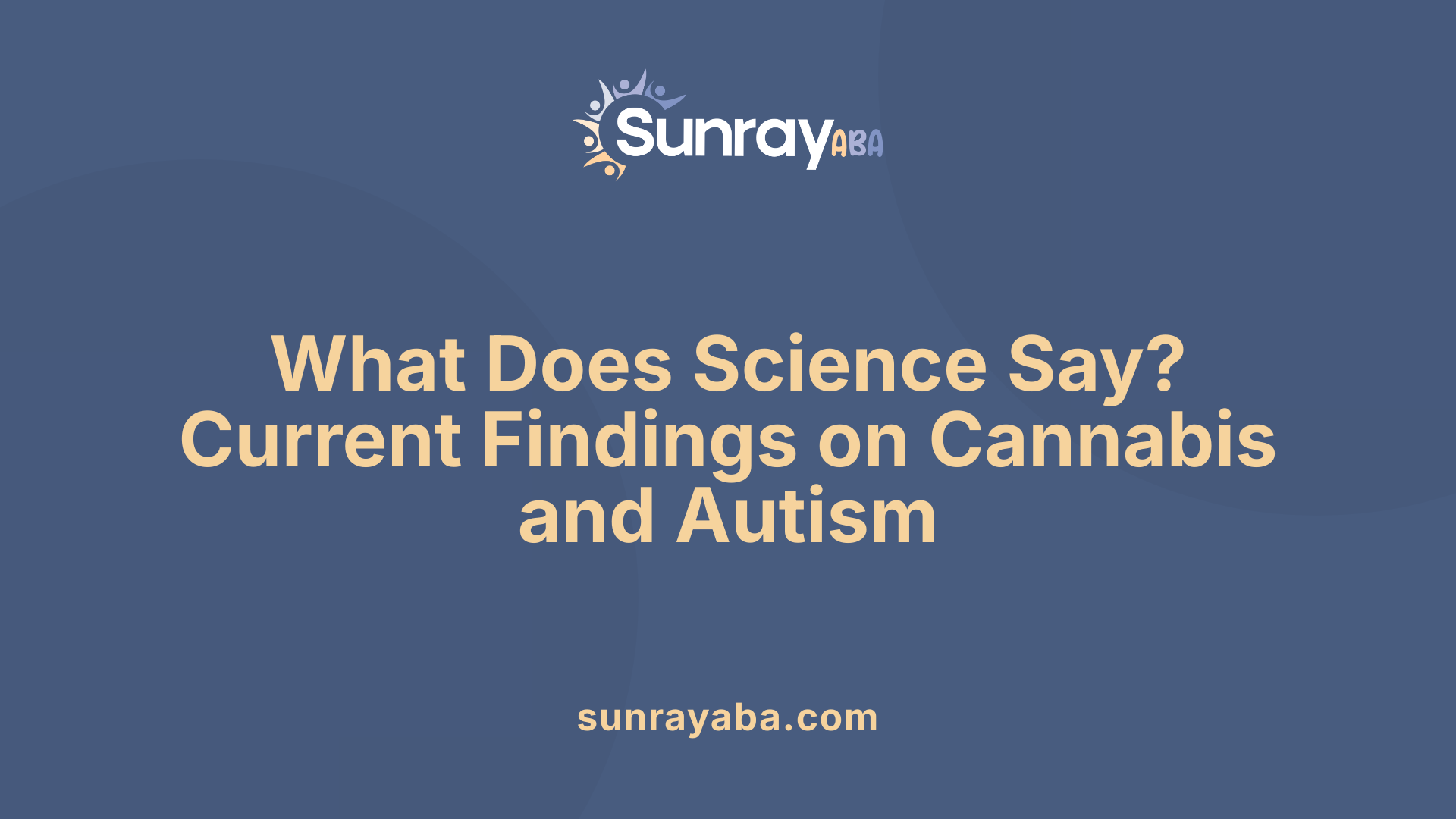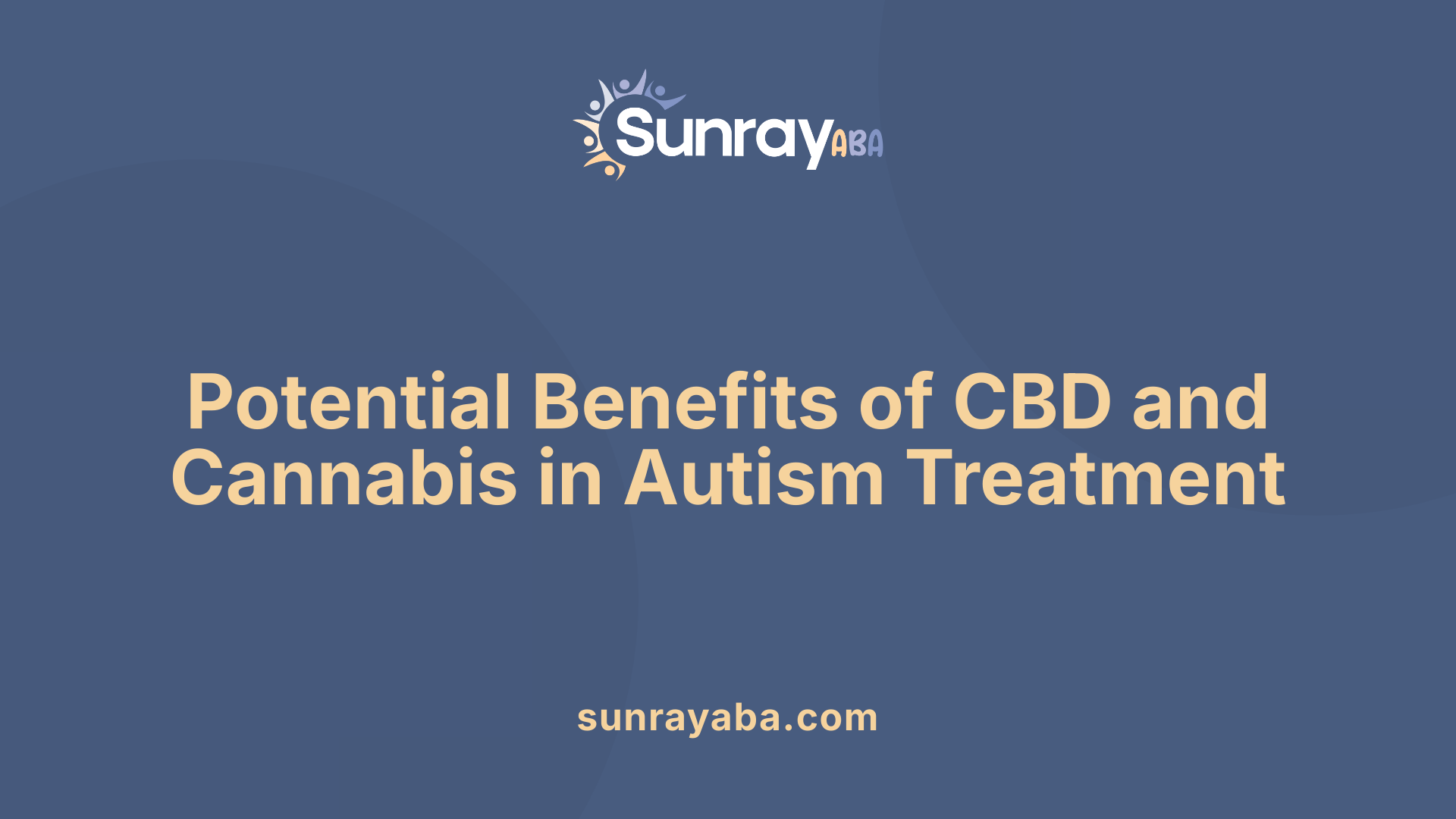Marijuana and Autism

An Emerging Field of Research and Practice
The relationship between marijuana and autism spectrum disorder (ASD) is an area of increasing scientific interest and clinical exploration. While current evidence remains preliminary, recent studies suggest that cannabinoids, especially CBD, may offer symptom relief for some individuals with autism. At the same time, concerns surrounding safety, genetic implications, and ethical considerations highlight the necessity for further rigorous research. This article delves into what is known, what remains uncertain, and the cautious optimism driving the investigation of marijuana's role in autism management.
Current Scientific Evidence on Marijuana and Autism

What scientific research exists on the relationship between marijuana and autism spectrum disorder (ASD)?
Research on marijuana's effects on ASD remains limited but shows several promising signs. Multiple studies and systematic reviews have suggested that cannabis products, especially those high in cannabidiol (CBD) and low in tetrahydrocannabinol (THC), may help alleviate some symptoms of ASD.
A review of nine studies indicated that cannabis may reduce behaviors such as hyperactivity, irritability, self-injury, anxiety, and sleep disturbances. Many parents and caregivers report improvements in social interaction, cognition, sensory sensitivities, and language abilities after using cannabis-based treatments.
For example, some clinical trials involving children and adolescents with severe ASD showed that CBD can improve social responsiveness and reduce aggressive behaviors. In one study, nearly two-thirds of participants experienced behavioral improvements, and the treatment was generally well tolerated.
However, the evidence base is still in early stages. Most studies lack control groups, have small sample sizes, and often rely on self-reports or observational data. Additionally, there’s concern about possible adverse effects, including sleep disturbances, nervousness, and changes in appetite.
Preclinical studies also point to potential risks, particularly regarding prenatal exposure. Animal research indicates that THC exposure during pregnancy may cause changes in fetal DNA methylation associated with neurodevelopmental disorders, suggesting a possible link between maternal cannabis use and increased ASD risk in offspring.
Overall, while initial findings are encouraging and suggest cannabis could offer a therapeutic option for some ASD symptoms, rigorous clinical trials are essential. Understanding long-term safety, appropriate dosing, and the effects of different cannabinoid formulations remains a priority for future research.
Therapeutic Potential of Cannabis in ASD Management

Are there potential therapeutic uses of cannabis and cannabinoids, such as CBD, for managing autism symptoms?
Current scientific evidence suggests that certain cannabis compounds, notably cannabidiol (CBD), may offer some relief for symptoms associated with autism spectrum disorder (ASD). Preliminary research and clinical observations indicate that CBD could help reduce anxiety, agitation, irritability, and hyperactivity. For example, a clinical trial involving boys with severe autism found that about two-thirds showed behavioral improvements upon treatment with CBD, including decreased aggressive behaviors and hyperactivity.
Moreover, some studies report that cannabis products can improve social responsiveness, sensory sensitivities, attention, and language skills in children with ASD. For instance, a systematic review of recent studies highlighted improvements in quality of life and reductions in disruptive behaviors when medical cannabis was administered, especially formulations high in CBD.
However, despite these promising findings, significant gaps remain. Most existing research lacks large, controlled clinical trials, making it difficult to definitively confirm efficacy. The current evidence is largely based on small sample sizes, observational studies, or studies without placebo controls.
Safety concerns also warrant caution. Although side effects like sleep disorders, restlessness, nervousness, and appetite changes are typically mild and transient, risks such as cognitive impairment, potential for increased psychiatric issues, and unknown long-term effects persist, especially in children and adolescents.
In summary, while cannabinoids like CBD show potential as a treatment option to manage some ASD symptoms, more rigorous research is necessary. Healthcare providers and caregivers should approach use carefully and prioritize evidence-based practices while awaiting further clinical trials and updated guidelines.
Safety, Risks, and Ethical Considerations

What are the safety concerns and potential risks associated with marijuana use in individuals with autism, including children and adolescents?
The use of marijuana and cannabinoids in young individuals with autism raises significant safety concerns. Research indicates that cannabis can cause neuropsychiatric effects such as anxiety, paranoia, and impairments in memory, learning, and attention. In children and adolescents, whose brains are still developing, marijuana use has been linked to disruptions in cognition and potentially lower IQ scores.
A major risk is the possible exacerbation of psychiatric conditions, including the development or worsening of psychotic and mood disorders. Early or high-potency exposure to cannabis, especially products with increased THC levels, has been associated with impairments in brain development and increased susceptibility to mental health issues like schizophrenia.
Studies also highlight that cannabis can interfere with neurodevelopmental trajectories, potentially worsening behavioral and cognitive challenges associated with autism.
Side effects from cannabis in this age group tend to include sleep disturbances, restlessness, and nervousness, which are often mild but may be more serious with extended use or high doses. Importantly, most cannabis products available in dispensaries are not regulated by the FDA, raising concerns about potency, purity, and safety.
Given these risks, careful medical supervision and thorough evaluation are essential before considering cannabis-based treatments for autism. Currently, evidence does not conclusively prove safety or effectiveness, emphasizing caution and the need for more rigorous research.
How does prenatal cannabis exposure affect autism risk and developmental outcomes?
Research on prenatal cannabis exposure suggests a complex picture. Some studies have shown that maternal use of cannabis during pregnancy may increase the likelihood of autism spectrum disorder in offspring. These potential risks are thought to stem from cannabis-related epigenetic changes—particularly DNA methylation—in genes associated with neurodevelopment.
Experiments involving pregnant animals, such as rhesus macaques and rats, found that THC exposure can alter DNA methylation in fetal tissues, affecting genes linked to neurobehavioral disorders and developmental pathways.
However, not all large studies show a direct link. Some cohort studies, including those from the NIH ECHO Program, report no statistically significant increase in autism risk after adjusting for confounding factors like maternal mental health and socioeconomic status.
Overall, while biological mechanisms point toward a possible influence of prenatal cannabis use on neurodevelopment, current evidence is inconclusive. The potential for increased autism risk remains plausible, but more definitive research is necessary to establish causality and understand the extent of impact.
Additional Information
| Aspect | Findings | Implications |
|---|---|---|
| Neurodevelopment | Potential epigenetic changes affecting autistic genes | Need for cautious use in pregnancy and further research |
| Cognitive development | Impaired memory, learning, and attention in youth | Risks of early exposure in developing brains |
| Psychiatric risk | Increased risk of psychosis, anxiety, mood disorders | Highlighting the importance of avoiding early or high-dose exposure |
| Regulatory stance | Lack of FDA-approved cannabis for children, variable product quality | Importance of medical supervision and regulation |
Research remains ongoing to clarify the full scope of risks associated with cannabis use and prenatal exposure impacting autism and development.
Genetic and Biological Mechanisms in Marijuana and Autism Link
What biological mechanisms and underlying factors link marijuana use and autism?
The connection between marijuana use and autism spectrum disorder (ASD) involves complex biological processes related to brain development and gene regulation.
One of the main biological pathways is the endocannabinoid system, which plays a vital role in neural development, social behaviors, mood regulation, and neuronal plasticity. This system includes endogenous molecules like anandamide (AEA), which helps modulate these processes. Studies have found that children with ASD often exhibit altered levels of AEA, suggesting that dysregulation in the endocannabinoid system might contribute to autism.
Cannabis contains phytocannabinoids such as CBD and THC, which can interact with this system. For instance, CBD has been shown to boost AEA levels by inhibiting FAAH, an enzyme that breaks down AEA. This interaction could potentially reduce some ASD symptoms like anxiety or hyperactivity by calming neural activity.
Beyond the endocannabinoid system, cannabis compounds can impact gene methylation and epigenetic modifications—processes that control gene expression without changing the DNA sequence. Recent research indicates that marijuana use, especially during critical periods like pregnancy, can lead to alterations in DNA methylation patterns, particularly in genes involved in neurodevelopment.
A notable example is the gene DLGAP2, associated with autism risk. Marijuana use can cause hypomethylation of DLGAP2 in sperm, potentially affecting its expression and inheritance. In animal models, such epigenetic changes have been observed in the brain regions of offspring, hinting at how parental cannabis exposure might influence neurodevelopment and autism risk.
Pregnancy exposure studies further support these findings, showing that maternal cannabis use can modify placental and fetal DNA methylation, impacting genes involved in brain development. This prenatal disruption might increase the likelihood of ASD, especially in male offspring.
While neuroimaging and preclinical research suggest these systems are implicated, direct evidence linking cannabis-induced biological changes with autism remains limited. Scientists acknowledge that further detailed studies are necessary to fully understand these mechanisms and their implications for neurodevelopment and ASD risk.
Current Scientific Consensus and Future Directions
What does current scientific consensus or systematic reviews say about marijuana's role in autism treatment?
Presently, the general scientific stance on using marijuana for autism symptom relief is cautious. Existing research is limited and often preliminary, with a lack of large, controlled clinical trials. Most systematic reviews highlight that while some studies suggest cannabis products, especially those high in CBD and low in THC, may improve certain behavioral aspects of ASD—such as aggression, hyperactivity, anxiety, and sleep disturbances—the evidence is not definitive.
Many studies show promise in alleviating multiple symptoms associated with autism, but their small sample sizes, absence of control groups, and variability in product formulations make it difficult to draw firm conclusions.
CBD, a non-psychoactive component of cannabis, has garnered particular interest. Some clinical trials indicate it may be safe and effective in reducing irritability and hyperactivity, with improvements noted in social responsiveness and sleep quality. However, these results are preliminary, and researchers emphasize the need for larger, well-controlled trials to confirm safety and efficacy.
The psychoactive component THC is associated with adverse effects, especially in children, such as impairments in cognition, increased risk of psychiatric disorders, and potential impacts on neurodevelopment. As such, current medical guidelines do not endorse the general use of cannabis for autism without further evidence.
Health authorities and experts advocate for more comprehensive studies to assess both short-term benefits and long-term risks, including possible neurodevelopmental impacts. Presently, the consensus underscores cautious optimism, pending more rigorous scientific validation.
| Aspect | Current Evidence | Future Research Needs | Additional Notes |
|---|---|---|---|
| Efficacy | preliminary, mixed results | larger, controlled trials | Focus on standardized dosing and formulations |
| Safety | generally mild short-term effects, unknown long-term risks | longitudinal studies on neurodevelopment and reproductive effects | Special caution in children and pregnant women |
| Regulatory Status | FDA-approved CBD medication for seizures | Clear guidelines for medicinal use | Most products sold are not FDA-regulated |
Overall, the consensus remains that cannabis and cannabinoids could have therapeutic potential but require substantial further validation before their routine clinical use in ASD can be recommended.
Navigating Clinical Potential and Caution
As research into marijuana's therapeutic potential for autism advances, it remains clear that cautious optimism must be balanced with rigorous scientific validation. While some cannabinoids, especially CBD, show promise for alleviating certain symptoms such as anxiety, aggression, and sensory overload, the lack of comprehensive clinical trials and long-term safety data necessitate careful consideration. Prenatal exposure and genetic implications underscore the importance of avoiding cannabis use during pregnancy and in reproductive contexts. Medical professionals, caregivers, and policymakers must collaborate to ensure that the evolving landscape of cannabis research is guided by evidence, safety, and ethical standards. Ultimately, more research is essential to establish clear guidelines, improve treatment options, and address the complex biological, psychological, and social facets of integrating marijuana into autism care.
References
- Cannabis and cannabinoid use in autism spectrum disorder
- Use of Medical Marijuana - Autism Science Foundation
- Prenatal exposure to cannabis may increase likelihood of autism
- Use of Medical Marijuana in Children and Adolescents with Autism ...
- Exposure to maternal cannabis use disorder and risk of autism ...
- Cannabis and cannabinoid use in autism spectrum disorder - PubMed
- Gene Linked to Autism Undergoes Changes in Men's Sperm After ...
- CBD Might Help Children with Autism, but More Research Needed
- How Medical Marijuana Helps Reduce Sensory Overload in Autism
- Cannabis Can 'Significantly Improve The Quality Of Life' For Youth ...